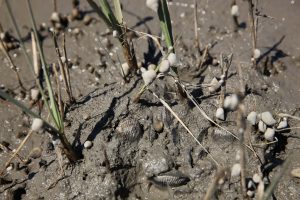Testing the Generality of top-down control in marine plant communities:

On the protected coastlines of Argentina and Brazil, I am beginning to examine the global generality of top-down control of marsh community structure with collaborators Dr. Mark Bertness and Dr. Oscar Iribarne (Mar de Plata University). In these extensive salt marshes, abundant herbivorous crabs, which are major prey items of a commercially harvested drum fish, also have the potential to denude marsh substrate and erase critical ecosystem services provided by coastal marshes.
Experimental examination of community organization in these systems may show again that the health and persistence of these important coastline communities are indirectly dependent on a trophic cascade, and thus susceptible, to human fishery activities. This new line of research will be a highly collaborative effort designed to provide South American students with resources and experiences necessary to lead research and conservation efforts in marine ecology.

We have already established exchanges of undergraduate and graduate students, with the goal of establishing mutual educational experiences between South American and U. S. students. These exchanges provide students with novel perspectives, expose them to new techniques and facilitate comparative studies.
As a professor, I will involve my graduate students in this work and use these marshes as partial training grounds and empowering experiences for their careers. In future research, I would also like to examine the rigor of established bottom-up forcing theory in other marine plant communities (i.e., seagrasses and mangroves). In these systems, invertebrate grazers injure live plants through shredding activities and facilitate invasion of pathogenic fungi in a similar manner to marsh snails.

The top-down effects of these grazers and predatory-controls on their populations, however, have not been thoroughly examined. Underestimating the role of consumers in controlling the structure and function of marine plant communities may therefore not be limited to salt marsh systems.
